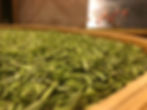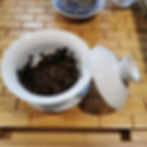Blog 170: Gaiwan Use: Close the Lid or Not?
- Valley Brook Tea
- Oct 8, 2020
- 3 min read
Gaiwan is the three-piece traditional tea-making tool. It commonly comes with a lid, the bowl, and a saucer. (Occasionally, it only has two-piece: the lid and the bowl.)
The name Gaiwan is literally the combination of the Chinese character Gai/盖(lid) and Wan/碗(bowl). As the name suggest, every single Gaiwan comes with a lid and the bowl/cup.
In case you are not familiar with Gaiwan, here is how Gaiwan works: you just put dry leaves in the bowl, then pour hot water into the bowl. After this, you close the lid immediately. With no steeping time, you just pour tea out right away. This entire process will take just under a few seconds. Again, no steeping time is required.
After you master this simple but skillful process, making a cup tea becomes a lot faster and easier. This is also exactly why we always recommend serious tea drinkers to use a traditional teaware set to prepare our tea products.

Of course, if you want to make a perfect cup of tea, there’re a few details in Gaiwan use you should probably know. Today, let’s discuss one important detail that many have ignored:
After the infusion, should you use the lid to cover the bowl, or keep the bowl uncovered?
Covering the bowl or leaving it open, what’s the different?
After infused with hot water, the fragrance substances in dry leaves are quickly released. If we keep the lid closed, tea leaves would keep releasing these fragrance substances due to the higher temperature. However, because the lid is closed, these fragrances won’t escape.
On the other hand, if we remove the lid and expose the leaves, leaves can cool down. As a result, fragrance substances can be better preserved because they wouldn’t release as fast as when it is hot. However, aromas would continue to escape because there’s no covering.
Also, some tender leaves can be burned by the hot steam if the lid is fully closed after the infusion. Removing the lid can avoid small and tender leaves getting damaged.

Should I close the lid or leave it open?
Many tea lovers might argue that we should always open the lid because it seems safer than keeping the lid closed. However, to close the lid or not depends on the situation.
In this blog, we’d like to discuss 4 situations.

1. Small and tender leaves – remove the lid
When it comes to very fresh, tender and small leaves, it is quite possible that the higher temperature raised by steam inside Gaiwan burns the leaves. Therefore, tea products that have small leaves such as Scent of Longan and Dragon Beard should not be covered in a Gaiwan.

2. Mature Leaves – leave a gap
Tea products with bigger, broader and stronger leaves can better withstand the heat. For example, oolong leaves are harvested between mid/late-April to mid-May. At the time of the harvest, oolong leaves are already grown to the full size. Therefore, even if we cover the bowl with the lid, oolong leaves wouldn’t get burned because of the heat.

In addition to this, covering the bowl can also help save the complex and charming aroma of the leaves.
In our DC store, our customers can choose to have the traditional teaware and make tea themselves. For the tea service, we nearly always recommend our guests to use the lid to loosely cover the bowl for most of our tea products.
3. Old and aged tea leaves – close the lid
For old and aged tea products, you can choose to close the lid completely. The constant higher temperature can more efficiently wake up the inner nutrient substances in tea leaves.
Common products in this category are aged white tea and dark tea products such as aged Shou Mei and Pu’er.

4. If your tea is getting weak too fast, you can close the lid
With more infusions, tea leaves get weaker and produce aromas and tastes slower. In practice, if you notice your tea is fading too fast, you can slow down the infusion and close the lid to prevent further loss of leaf aromas.
We hope you enjoyed today’s blog. As always, if you have questions or suggestions, please leave a comment, tweet us @valleybrooktea or email the author directly at zhang@valleybrooktea.com. Please also follow us on Instagram @valleybrooktea and join our mail list to get our daily tea updates and our latest promotions!
This is a Valley Brook Tea original blog. All rights reserved.

